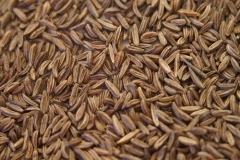Caraway
| Infobox on Caraway | |
|---|---|
| Example of Caraway |  |
| Facts | |
| Origin | W. Asia, Europe, N. Africa |
| Stowage factor (in m3/t) | - |
| Humidity / moisture |
|
| Ventilation | See text |
| Risk factors | See text |
Caraway
Description
Caraway (Carum carvi), also known as meridian fennel, or Persian cumin, is a biennial plant in the family Apiaceae, native to western Asia, Europe and Northern Africa.
The plant is similar in appearance to other members of the carrot family, with finely divided, feathery leaves with thread-like divisions, growing on 20–30 cm stems. The main flower stem is 40–60 cm tall, with small white or pink flowers in umbels. Caraway fruits (erroneously called seeds) are crescent-shaped achenes, around 2 mm long, with five pale ridges.
The plant prefers warm, sunny locations and well-drained soil rich in organic matter. In warmer regions it is planted in the winter months as an annual. In temperate climates it is planted as a summer annual or biennial. There is however a polyploid variant of this plant that was found to be perennial.
Caraway, like many umbellifers, is a useful companion plant. It can hide the scent of neighboring crops from pest insects, as well as attracting beneficial insects like predatory wasps and predatory flies to its flowers.
Caraway is the mature, dried schizocarpic fruit of a biennial herb of the parsley family (Umbelliferae). Each schizocarpic fruit is formed of two caraway seeds and divides into the two half-fruits when mature. These are 3 - 7 mm long, 1.5 - 2 mm wide, crescent-shaped, pointed at both ends, dark brown and have 5 yellowish ridges. The umbels are cut shortly before they reach maturity and dried.
The term spice is used to refer to plant parts which serve to improve the odor and flavor of foods. They contain essential oils and other ingredients which have a strong seasoning action.
Spices are processed, cleaned, graded and carefully packaged for overseas dispatch in the countries where they are cultivated. They are dried to preserve them for transport and storage. In consumer countries, they are delivered to spice mills, where they are cleaned and graded again, ready for sale in unground or ground form.
Application
The fruits, usually used whole, have a pungent, anise-like flavor and aroma that comes from essential oils, mostly carvone and limonene. They are used as a spice in breads, especially rye bread.
Caraway is also used in desserts, liquors, casseroles, curry and other foods. It is more commonly found in European cuisine. For example, it is commonly used in British caraway seed cake and is also added to sauerkraut. It is also used to add flavor to cheeses such as bondost, pultost, nøkkelost and havarti. Akvavit and several liqueurs are made with caraway. In Middle Eastern cuisine, caraway pudding is a popular dessert during Ramadan.
The roots may be cooked as a root vegetable like parsnips or carrots.
Caraway fruit oil is also used as a fragrance component in soaps, lotions, and perfumes.
Shipment / Storage
Caraway is packaged in jute fabric bags (50 kg), among other things.
Standard containers may be used, subject to compliance with lower limits for water content of goods, packaging and container flooring.
Caraway may be kept for approx. 12 months if the recommended storage conditions are complied with.
Favorable travel temperature range: 5 - 25°C
Caraway should be transported in areas which exhibit the lowest temperatures during the voyage and are dry. In any event, storage beneath the weather deck or, in the case of shipping in containers, in the uppermost layer on deck, must be avoided as the deck or container is strongly heated by the intense tropical sun and, at temperatures of > 25°C, essential oils may be lost and there is a risk of self-heating.
Spices are hygroscopic goods (hygroscopicity), which interact with the moisture in the air. The risk of mold growth is naturally at its greatest in warm, damp air. The cargo may become musty, and the risk of self-heating increases with an elevated air moisture content.
Caraway should be stowed away from goods which are sensitive to moisture/humidity or release moisture.
In order to prevent condensation on the ship's side or container walls from affecting the cargo, care should be taken to leave a clear gap between the cargo stack and the ship's side or container wall; the stowage space should be cool, dry and, most particularly, easy to ventilate.
If the product is at "shipping dryness", it does not have to be ventilated during transport. However, if the water content does not meet these guidelines, the recommended ventilation conditions are an air exchange rate of 6 changes/hour (airing)
Risk factors
- Moisture damage
- Self-heating / Spontaneous combustion (5.0 - 7.0% essential oils and up to 12% fatty oils.
- Odor
- Contamination
- Shrinkage/Shortage
- Insect infestation / Diseases











